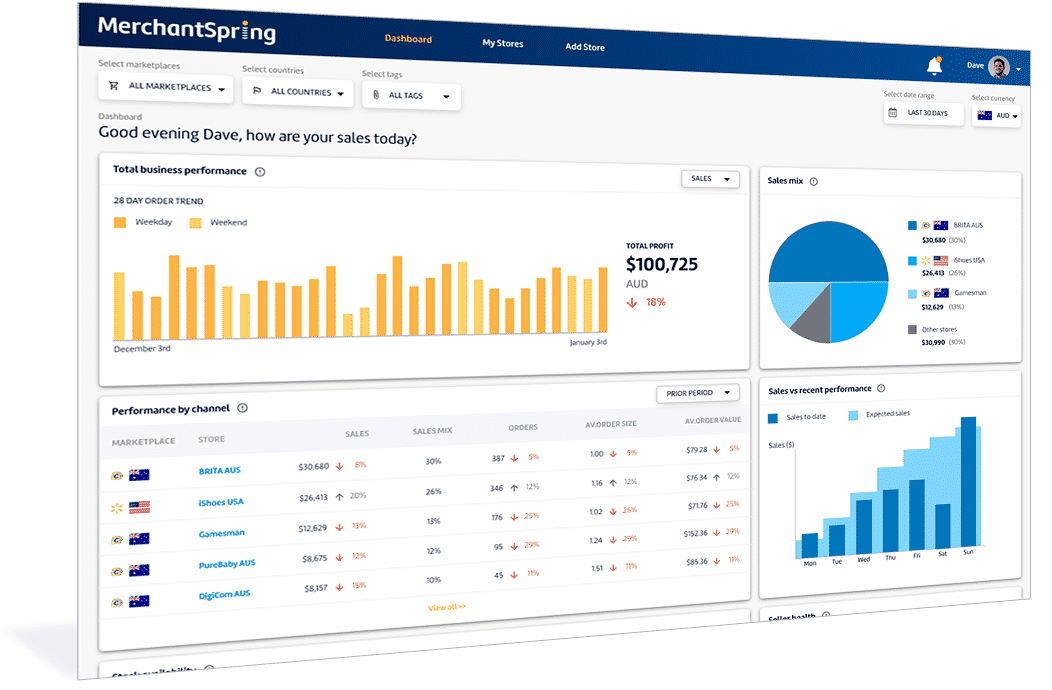FMCG Brands: Align Sales and Marketing to Win on Amazon
Overview
Amazon Vendor Central has matured rapidly, yet many fast‑moving consumer goods (FMCG) brands still treat the platform as a sales‑only channel. In an episode of the Marketplace Masters webinar, Alexandros Karagiannis (Managing Director of Lezzat) and Paul Sonneveld (CEO of MerchantSpring) explored why marketing teams often overlook Amazon data and how that disconnect undermines brand growth. This article synthesises their insights into a thought‑leadership narrative for Amazon vendor managers, brand marketers and agencies serving FMCG clients. We’ll examine the metrics that matter, discuss emerging technology trends, and offer practical advice to align marketing objectives with Amazon’s unique ecosystem.
Throughout this piece, we'll refer to key metrics such as impressions, click‑through rates (CTR), share of voice, new‑to‑brand sales, conversion rate and subscribe‑and‑save adoption—metrics that leading advertisers track to gauge brand health. We’ll also draw on research about Total Advertising Cost of Sales (TACoS), Return on Ad Spend (ROAS) and the benefits of Amazon’s Subscribe & Save program. Finally, we highlight the growing role of generative AI and Amazon Marketing Cloud (AMC) to create effective ads and unlock deep insights.
Understanding Marketer Needs: Why Sales Data Alone Isn’t Enough
Karagiannis noted that many FMCG businesses assign massive above‑the‑line budgets for traditional advertising yet treat Amazon as an afterthought. These companies often fail to repurpose existing creative assets for Amazon, or they localise content for different territories without collaborating across regions. The result is fragmented branding and underutilised marketing material. Disconnects between sales teams and marketers also arise because Amazon vendor managers focus on purchase orders and sales volumes, while marketing departments prioritise brand awareness, engagement and customer loyalty.
During the webinar, Karagiannis described a typical scenario: a multi‑market FMCG brand invests heavily in video and image creatives for television or YouTube but never adapts those assets for Amazon. He argued that “with just small edits—cropping a 45‑second TV ad to a 30‑second Amazon spot or adding captions for localisation—the brand could unlock additional awareness and market share” (paraphrasing his remarks). Yet many marketing teams lack visibility into Amazon's performance data, leaving decisions to sales teams or external agencies.
Key takeaway: Marketing teams must treat Amazon as a full‑funnel channel, not just a sales outlet. That means investing in creative adaptation, understanding platform metrics and collaborating cross‑regionally.
Essential Amazon Vendor Metrics for Marketers
Marketing and analytics professionals thrive on data. However, the Amazon Vendor Central dashboard differs from other retail platforms, and there’s often confusion about which metrics matter. Below is a primer on the key performance indicators (KPIs) and why marketers should monitor them.

1. Brand Visibility and Engagement
Impressions and click‑through rate (CTR). Impressions indicate how often your ads or listings appear. CTR measures the percentage of shoppers who click after seeing your ad. According to a guide on Amazon marketing metrics, impressions and CTR help brands understand whether they are breaking into new markets and maintaining visibility.
“Show tangible results: when Amazon becomes your biggest retailer, senior leadership and marketing teams suddenly pay attention.” — Alexandros Karagiannis
Share of Voice (SOV). SOV compares your ad impressions to competitors, revealing your brand’s presence relative to the category. Some advertisers differentiate branded versus non‑branded impressions to gauge awareness among new audiences. Dominating top‑of‑search impressions can significantly impact market share.
2. Customer Acquisition and New‑to‑Brand Sales
Amazon now provides new‑to‑brand (NTB) metrics that quantify the percentage of purchases from shoppers who haven’t bought your products within the last year. This indicator helps marketers evaluate acquisition campaigns and understand whether paid ads are reaching fresh audiences rather than cannibalising existing customers. Karagiannis suggested that focusing on NTB metrics prevents agencies from “over‑inflating ROAS by bidding only on branded keywords,” which tends to drive existing customers back rather than attracting new ones.
Subscribe & Save adoption rate. Subscribe & Save is Amazon’s replenishment program that encourages repeat purchases. Customers can subscribe to regular deliveries at discounted rates (5–15%) and manage frequencies easily. For brands, a high Subscribe & Save adoption rate signifies strong customer loyalty and lifetime value—critical metrics for FMCG products with recurring consumption. The program also boosts brand perception and defends market share by shielding products from unauthorized resellers.
“Advertising is becoming more complicated. We can’t rely solely on exact‑match keywords; we need to explore Subscribe & Save and new‑to‑brand audiences to increase market share.” — Alexandros Karagiannis
3. Sales Efficiency and Profitability
Return on Advertising Spend (ROAS) and Advertising Cost of Sales (ACOS). ROAS measures revenue generated per dollar spent on ads; ACOS is the inverse (ad spend divided by sales). Both metrics help marketers evaluate campaign efficiency. However, focusing solely on ROAS can be misleading if the ads primarily target existing customers.
Total Advertising Cost of Sales (TACoS). TACoS compares advertising spend to total revenue—including organic sales. It offers a holistic view of how advertising drives overall business growth. As analytics experts point out, TACoS is a long‑term metric that reveals whether advertising efforts are fostering sustainable growth.
Conversion rate and Average Order Value (AOV). Conversion rate measures the percentage of listing visitors who purchase, while AOV reflects the average revenue per order. Improving product detail pages and cross‑selling complementary items can boost both metrics.
4. Repeat Purchase Rate and Brand Loyalty
Repeat purchase rate. This metric tracks how many customers repurchase your product within a given period. High repeat rates demonstrate strong brand loyalty—a critical objective for FMCG brands. Combining repeat purchase rate with Subscribe & Save adoption reveals whether customers are transitioning from one‑off purchases to scheduled subscriptions.
5. Emerging Insights from Amazon Marketing Cloud (AMC)
AMC is a secure, privacy‑compliant data clean room that lets advertisers run custom queries on anonymised Amazon data. According to a 2025 trends report, AMC helps brands answer questions such as time to conversion, lifetime value (LTV), path‑to‑conversion, multi‑touch attribution and ASIN overlap. By integrating AMC data with first‑party analytics, marketers can create custom audiences—for example, cart abandoners, detail page viewers or high‑value NTB purchasers—and tailor campaigns accordingly.
Harnessing Generative AI and Automation
The webinar acknowledged that marketing teams are increasingly stretched. New channels such as TikTok, live shopping and social commerce require attention, while AI technologies change how creative assets are produced. Amazon Ads is investing heavily in generative AI to help advertisers create high‑quality images, videos and audio assets directly within the platform. The company’s head of product and technology, Jay Richman, described how AI tools can generate multiple ad variants, adapt content to different audiences and contexts and integrate brand safety controls.
These advances democratize advertising by reducing production time and cost. Even small and medium‑sized brands can experiment with video ads—a format that drives higher engagement. The aiCommerce trends report predicts that generative AI, AMC accessibility and video advertising will be among the top Amazon trends in 2025. For vendor managers, this means exploring AI‑enabled creative tools within Amazon Ads and testing new ad formats beyond Sponsored Products.
Closing the Loop: Training and Organisational Models
One of the most intriguing points in the webinar was the organisational challenge. Who owns the Amazon channel? In many FMCG firms, responsibilities are split: sales handles purchase orders, marketing oversees brand campaigns, and a global centre of excellence supervises compliance. Karagiannis observed that some corporations have even created dedicated Amazon departments with dozens of staff. Others outsource to agencies like Lezzat or leverage platforms like MerchantSpring for analytics.
Regardless of structure, both speakers agreed that education is critical. Marketing teams need to understand how to navigate Vendor Central, analyse PPC reports, interpret AMC queries and adapt content. Karagiannis recommended building internal libraries of source files so regional teams can localise assets without starting from scratch. He also emphasised training sessions, booklets or interactive playbooks that answer common questions and provide step‑by‑step guidance.
Practical Tips for Better Collaboration
- Map your key metrics to business objectives. Identify what insights the marketing team needs—brand awareness, customer acquisition or loyalty—and ensure the Amazon reporting dashboards deliver those metrics.
- Centralise your creative assets. Maintain an organised library with editable source files (images, videos, A+ content) that local teams can adapt for different territories.
- Leverage Subscribe & Save to build LTV. Encourage subscriptions by offering coupons or incentives; monitor adoption rates to gauge loyalty.
- Invest in training and knowledge sharing. Provide workshops or digital playbooks so marketers understand how to extract data, interpret metrics and collaborate with sales and agency partners.
- Explore Amazon Marketing Cloud. Use AMC to answer advanced questions about customer journeys and to build custom audiences.
- Experiment with AI‑generated creative. Test Amazon’s AI tools for generating video and image assets and evaluate performance across different audiences.
- Track new‑to‑brand and repeat purchase metrics. Don’t rely on ROAS alone; use NTB and Subscribe & Save adoption to measure long‑term brand growth.
Conclusion: Turning Data into Action
FMCG brands that treat Amazon as a purely transactional channel are leaving value on the table. By embracing a data‑driven, collaborative approach, vendors can align sales objectives with marketing goals. Start by monitoring the right metrics—impressions, CTR, new‑to‑brand share, repeat purchase rate and Subscribe & Save adoption. Use TACoS and AMC insights to connect advertising spend with overall business growth. Invest in generative AI tools to scale creative production and test new ad formats. And above all, foster a culture of knowledge sharing and continuous training across sales, marketing and agency partners.
Ready to level up your Amazon strategy? Watch the full Marketplace Masters episode to hear Paul Sonneveld and Alexandros Karagiannis discuss these topics in depth. If you’re an agency or FMCG brand seeking deeper analytics, explore MerchantSpring’s vendor analytics platform and reach out for a personalised demo. By uniting sales and marketing under a shared vision, your brand can unlock Amazon’s full potential.


-Oct-07-2025-01-28-02-8972-AM.png)











Add a Comment